战略管理概念与案例英文版.原书第十五版课程设计 (2)
战略管理概念与案例pdf
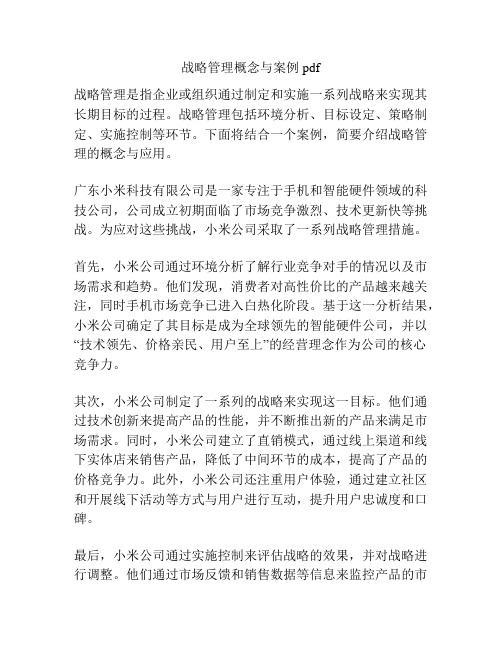
战略管理概念与案例pdf战略管理是指企业或组织通过制定和实施一系列战略来实现其长期目标的过程。
战略管理包括环境分析、目标设定、策略制定、实施控制等环节。
下面将结合一个案例,简要介绍战略管理的概念与应用。
广东小米科技有限公司是一家专注于手机和智能硬件领域的科技公司,公司成立初期面临了市场竞争激烈、技术更新快等挑战。
为应对这些挑战,小米公司采取了一系列战略管理措施。
首先,小米公司通过环境分析了解行业竞争对手的情况以及市场需求和趋势。
他们发现,消费者对高性价比的产品越来越关注,同时手机市场竞争已进入白热化阶段。
基于这一分析结果,小米公司确定了其目标是成为全球领先的智能硬件公司,并以“技术领先、价格亲民、用户至上”的经营理念作为公司的核心竞争力。
其次,小米公司制定了一系列的战略来实现这一目标。
他们通过技术创新来提高产品的性能,并不断推出新的产品来满足市场需求。
同时,小米公司建立了直销模式,通过线上渠道和线下实体店来销售产品,降低了中间环节的成本,提高了产品的价格竞争力。
此外,小米公司还注重用户体验,通过建立社区和开展线下活动等方式与用户进行互动,提升用户忠诚度和口碑。
最后,小米公司通过实施控制来评估战略的效果,并对战略进行调整。
他们通过市场反馈和销售数据等信息来监控产品的市场表现,并及时优化和改进产品。
此外,小米公司还积极面对竞争对手的挑战,通过合作和并购等手段来增强自身的实力。
通过以上的战略管理措施,小米公司成功地实现了快速发展,并逐渐成为全球领先的智能硬件公司之一。
综上所述,战略管理是企业或组织在竞争环境中通过制定和实施一系列战略来实现长期目标的过程。
通过环境分析、目标设定、策略制定、实施控制等环节,企业可以应对市场竞争和风险,实现持续发展。
小米公司的案例向我们展示了战略管理的具体应用,通过技术创新和价格竞争力等策略,成功实现了企业的目标。
战略管理概念与案例(PPT 42张)
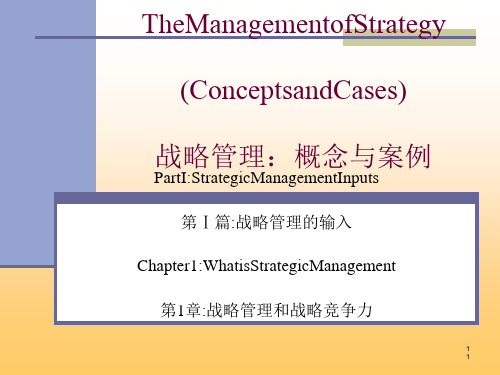
PartI:StrategicManagementInputs
第Ⅰ篇:战略管理的输入
战略管理:概念与案例
Chapter1:WhatisStrategicManagement
第1章:战略管理和战略竞争力
1 1
Chapter 1: What is Strategic Management 第1章: 战略管理和战略竞争力
Overview: Eight content areas 概要: 八大领域
Nature of Competition
战略竞争力的特性
The 21st Century Competitive Landscape
21世纪的竞争格局
I/O Model of Above-Average Returns (AAR)
Strategy 战略 Integrated and coordinated set of commitments and actions designed to exploit core competencies and gain a competitive advantage 设计用来开发核心竞争力、获取竞争优势的一系列综和的、 协调的约定和行动
6
1. Nature of Competition: Basic concepts 竞争力的特性: 基本概念
Competitive Advantage (CA) 竞争优势 (CA) Implemented strategy that competitors are unable to duplicate or find too costly to imitate 实施的战略竞争对手不能复制或因成本太高而无法 模仿 Above Average Returns 超额利润 Returns in excess of what investor expects in comparison to other investments with similar risk 一项投资的利润超过投资者预期能从其他相同风险 的投资项目获得的利润
战略管理概念与案例英文版.原书第十五版教学设计
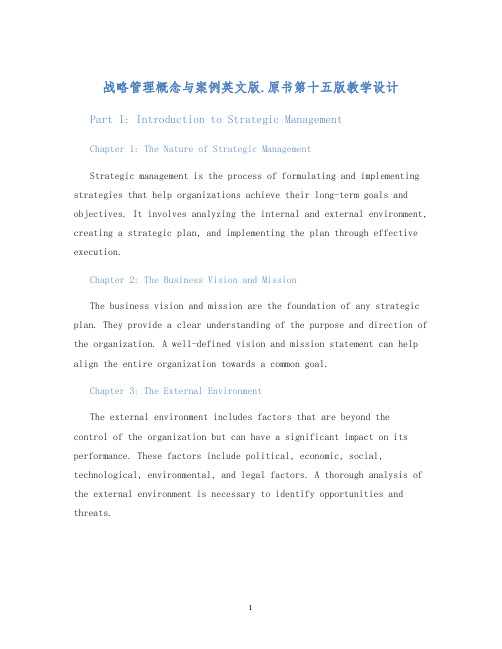
战略管理概念与案例英文版.原书第十五版教学设计Part I: Introduction to Strategic ManagementChapter 1: The Nature of Strategic ManagementStrategic management is the process of formulating and implementing strategies that help organizations achieve their long-term goals and objectives. It involves analyzing the internal and external environment, creating a strategic plan, and implementing the plan through effective execution.Chapter 2: The Business Vision and MissionThe business vision and mission are the foundation of any strategic plan. They provide a clear understanding of the purpose and direction of the organization. A well-defined vision and mission statement can help align the entire organization towards a common goal.Chapter 3: The External EnvironmentThe external environment includes factors that are beyond thecontrol of the organization but can have a significant impact on its performance. These factors include political, economic, social, technological, environmental, and legal factors. A thorough analysis of the external environment is necessary to identify opportunities and threats.Chapter 4: Internal AnalysisInternal analysis looks at the strengths and weaknesses of the organization. It includes analyzing the organization’s resources, capabilities, and core competencies. A thorough understanding of the organization’s internal environment is necessary to develop effective strategies.Part II: Strategy FormulationChapter 5: Business-Level StrategyBusiness-level strategy involves identifying the target market and developing a competitive advantage in that market. There are three generic business-level strategies: cost leadership, differentiation, and focus.Chapter 6: Corporate-Level StrategyCorporate-level strategy involves identifying the businesses in which the organization should compete and the resource allocation among those businesses. It includes identifying diversification strategies, such as vertical integration, horizontal integration, and related diversification.Chapter 7: International StrategyIn ternational strategy involves expanding the organization’s business operations outside its home country. It includes analyzing the cultural, political, legal, and economic factors of the new market.Chapter 8: Entrepreneurial Strategy and Competitive DynamicsEntrepreneurial strategy involves identifying and exploiting new opportunities in the market. Competitive dynamics focus on the interactions between companies in the marketplace.Part III: Strategy ImplementationChapter 9: Strategic Control and Corporate GovernanceStrategic control and corporate governance ensure that the organization is achieving its strategic goals and objectives. It includes setting performance metrics and monitoring the organization’s progress.Chapter 10: Organizational Design, Structure, and CultureOrganizational design, structure, and culture are all critical components of effective strategy implementation. They help align the organization towards a common goal and ensure that resources are effectively utilized.Chapter 11: Leadership and Strategic ChangeLeadership is crucial in implementing change and ensuring that the organization is adapting to new strategies. Effective leaders are able to communicate the vision, motivate employees, and manage the change process.Part IV: Case AnalysisCase 1: Apple Inc.Apple Inc. is one of the world’s most successful and innovative companies. This case study analyzes Apple’s strategic management approach, including its business-level and corporate-level strategies.Case 2: Amazo is the world’s largest online retler. This case study analyzes Amazon’s strategy, including how it became a dominant player in the e-commerce market and its expansion into new markets.Case 3: NetflixNetflix is a leading provider of online streaming services. This case study analyzes Netflix’s business-level and corporate-level strategies, including its entry into new markets and its response to changing customer needs.ConclusionStrategic management is a dynamic process that requires continuous analysis and adaptation. By understanding the concepts and principles of strategic management, students can develop the skills necessary to create and implement effective strategies in a diverse range of organizations. The case studies provide practical examples of how these concepts and principles are applied in real-world situations.。
战略管理(英文版)
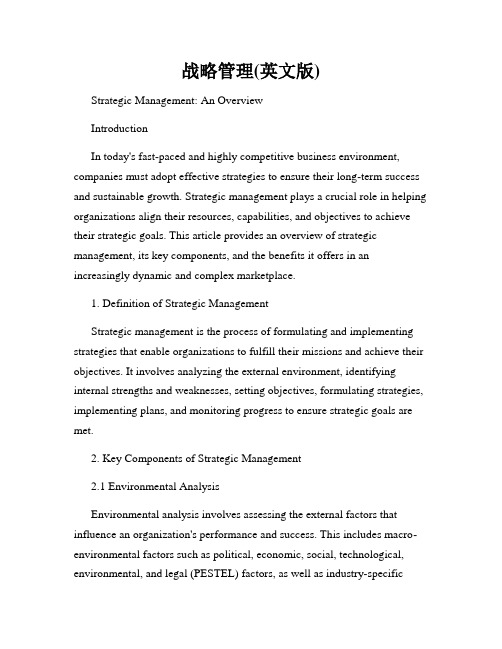
战略管理(英文版)Strategic Management: An OverviewIntroductionIn today's fast-paced and highly competitive business environment, companies must adopt effective strategies to ensure their long-term success and sustainable growth. Strategic management plays a crucial role in helping organizations align their resources, capabilities, and objectives to achieve their strategic goals. This article provides an overview of strategic management, its key components, and the benefits it offers in an increasingly dynamic and complex marketplace.1. Definition of Strategic ManagementStrategic management is the process of formulating and implementing strategies that enable organizations to fulfill their missions and achieve their objectives. It involves analyzing the external environment, identifying internal strengths and weaknesses, setting objectives, formulating strategies, implementing plans, and monitoring progress to ensure strategic goals are met.2. Key Components of Strategic Management2.1 Environmental AnalysisEnvironmental analysis involves assessing the external factors that influence an organization's performance and success. This includes macro-environmental factors such as political, economic, social, technological, environmental, and legal (PESTEL) factors, as well as industry-specificfactors. Understanding the external environment helps organizations identify opportunities and threats and make informed strategic decisions.2.2 Internal AnalysisInternal analysis focuses on assessing an organization's internal strengths and weaknesses. This includes evaluating its resources, capabilities, and core competencies. By understanding its internal strengths, an organization can leverage them to gain a competitive advantage. Similarly, identifying weaknesses helps organizations address potential areas of improvement and overcome challenges.2.3 Strategy FormulationStrategy formulation involves developing a comprehensive plan to achieve an organization's objectives and competitive advantage. This includes defining the mission and vision, setting strategic objectives, and selecting appropriate strategies. Strategies can be categorized into corporate, business, and functional levels, depending on the scope and focus of the organization's activities.2.4 Strategy ImplementationStrategy implementation is the process of translating strategic plans into actions and ensuring their effective execution. It involves allocating resources, coordinating activities, and monitoring progress. Effective implementation requires strong leadership, effective communication, and a supportive organizational culture.2.5 Evaluation and ControlEvaluation and control involve monitoring and reviewing the progress of strategic initiatives and making necessary adjustments. This includes establishing key performance indicators, conducting regular performance assessments, and taking corrective actions to ensure strategic goals are being achieved. Evaluation and control help organizations stay on track and make informed decisions throughout the strategic management process.3. Benefits of Strategic ManagementStrategic management offers several benefits to organizations:3.1 Clear DirectionBy formulating a clear strategy, organizations establish a sense of direction and purpose. This enables employees to align their efforts and work towards common goals, enhancing overall organizational performance.3.2 Competitive AdvantageStrategic management helps organizations identify unique value propositions and differentiate themselves from competitors. By leveraging their strengths and focusing on key opportunities, organizations can gain a competitive advantage in the marketplace.3.3 Adaptability to ChangeIn today's rapidly evolving business landscape, agility and adaptability are essential for success. Strategic management enables organizations to anticipate and respond to changes in the external environment, ensuring their long-term viability in a dynamic marketplace.3.4 Resource AllocationStrategic management facilitates effective resource allocation by aligning financial, human, and technological resources with strategic objectives. This ensures optimal utilization of resources and maximizes the organization's ability to achieve its goals.3.5 Performance MeasurementBy implementing strategic objectives and monitoring progress, organizations can measure their performance and identify areas for improvement. This allows for continuous learning and ongoing improvement, enhancing overall organizational effectiveness.ConclusionStrategic management is a fundamental process that enables organizations to navigate the complexities of the modern business landscape. By analyzing the external environment, assessing internal capabilities, formulating effective strategies, implementing plans, and evaluating performance, organizations can achieve their objectives and thrive in a highly competitive marketplace. Embracing strategic management is essential for long-term success and sustainability.。
战略管理概念与案例英文版.原书第十五版课程设计
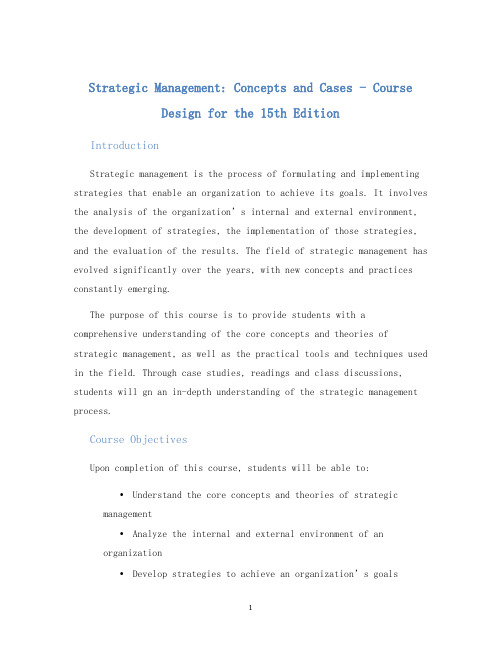
Strategic Management: Concepts and Cases - CourseDesign for the 15th EditionIntroductionStrategic management is the process of formulating and implementing strategies that enable an organization to achieve its goals. It involves the analysis of the organization’s internal and external environment, the development of strategies, the implementation of those strategies, and the evaluation of the results. The field of strategic management has evolved significantly over the years, with new concepts and practices constantly emerging.The purpose of this course is to provide students with a comprehensive understanding of the core concepts and theories of strategic management, as well as the practical tools and techniques used in the field. Through case studies, readings and class discussions, students will gn an in-depth understanding of the strategic management process.Course ObjectivesUpon completion of this course, students will be able to:•Understand the core concepts and theories of strategic management•Analyze the internal and external environment of an organization•Develop strategies to achieve an organization’s goals•Implement strategies effectively•Evaluate the results of strategic management initiatives Course StructureThe course will be divided into the following sections:Section 1: Introduction to Strategic Management•Overview of strategic management•Historical development of strategic management•Importance of strategic management•Key concepts in strategic managementSection 2: Analyzing the Environment•External environment analysis•Internal environment analysis•SWOT analysis•Porter’s Five Forces analysisSection 3: Strategy Development•Corporate-level strategy•Business-level strategy•International strategy•Competitive strategySection 4: Strategy Implementation•Organizational structure and design•Culture and leadership•Managing change•Resource allocationSection 5: Evaluation and Control•Measuring performance•Feedback and learning•Adjusting strategiesSection 6: Case Studies•Harvard Business School Case Studies•Other selected case studies Evaluation Criteria•Class participation (20%)•Written assignments (40%)•Case study analysis (20%)•Final exam (20%)TextbookThe textbook for this course is。
战略管理概念与案例

约定和行动
6
第六页,共四十三页。
1. Nature of Competition: Basic concepts
竞争力的特性: 基本概念
■ Competitive Advantage (CA) 竞争优势(CA)
■ Implemented strategy that competitors are unable to duplicate or find too costly to imitate
■ Strategic Management Process (SMP)战略管理过程(SMP)
■ Full set of commitments, decisions and actions required for a firm to achieve strategic competitiveness and earn above average returns
15
第十五页,共四十三页。
3. 21st Century Competitive Landscape
21世纪竞争格局
3.2.2 Technology and Technology Changes (Cont’d)
技术和技术进步
1) Technology diffusion技术扩散
■ Perpetual innovation: describes how new informationintensive technologies are replacing older forms持续创新 容信息密集型的新技术如何快速和有效地替代旧技术
■ Speed to market may be primary competitive advantage进入 市场的速度几乎成为最主要的竞争优势
Strategic Management Concepts and Cases战略管理概念与案例

21st Century Competitive Landscap
■ Introduction: The Competitive Landscape (CL)
■ Pace of change i s rapid ■ P a r t n e r s h i p s c r e a t e d by mergers &a c q u i s i t i o n s (M& ■ Other CL c h a r a c t e r i s t i c s : Economies of s c a l e ,
· Destroy value of existing technology · Create new markets
12
21st Century Competitive Landscape
■ Technology and Technology Changes (Cont’d)
■ 1 . Technology d i f f u si o n &d i s r u p t i v e technologie ■ 2 . The information age ■ 3 . Increasing knowledge i n t e n s i t y
6
Chapter 1 : S t r a t e g i c Management and Strategic Competitiventent areas
■ Nature of Competition ■ The 21st Century Competitive Landscape ■ I/O Model of Above-Average Returns (AAR) ■ Resource-Based Model of AAR ■ Stra te gic Vision and Mission ■ Stakeholders ■ Strategic Leaders ■ The S t r a t e g i c Management Process
战略管理课件英文版Ch6CorporateLevelStrategy48P

21
Levels and Types of Diversification
Moderate to High Levels of Diversification
Related Constrained
<70% of revenues from dominant business; all businesses share product, technological and distribution linkages
28
Managerial Motives to Diversify
Managers have motives to diversify:
– diversification increases size; size is associated with executive compensation
– diversification reduces employment risk – effective governance mechanisms may restrict
7
This is what Pepsi used to look like
8
Pepsi’s experiment with fast food
Pepsi acquires Pizza Hut in 1977, Taco Bell in 1978 and KFC in 1986.
In 1997, Pepsi spins off all three as Tricon ($11B with 29,000 restaurants). They are now part of Yum! Brands.
战略管理英文版最新版教学ppt课件第2章

➢ U.S. Railroads: "Safest… N. American railroad”
❖ Missed the chance to move into delivery before UPS & Federal Express
➢ Delight our customers, employees, and shareholders by relentlessly delivering the platform and technology advancements that become essential to the way we work and live
LO 2-4 Critically evaluate the relationship between mission statements and competitive advantage.
LO 2-5 Explain why anchoring a firm in ethical values is essential for long-term success.
LO 2-6 Compare and contrast strategic planning, scenario planning, and strategy as planned emergence, and discuss strategic implications.
2-3
ChapterCase 2 Teach For America: Inspiring Future Leaders • TFA Mission: Eliminate educational inequality
战略管理 概念与案例
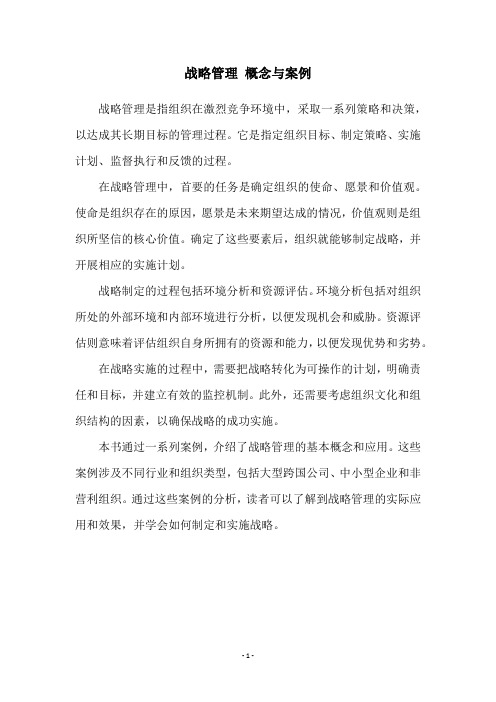
战略管理概念与案例
战略管理是指组织在激烈竞争环境中,采取一系列策略和决策,以达成其长期目标的管理过程。
它是指定组织目标、制定策略、实施计划、监督执行和反馈的过程。
在战略管理中,首要的任务是确定组织的使命、愿景和价值观。
使命是组织存在的原因,愿景是未来期望达成的情况,价值观则是组织所坚信的核心价值。
确定了这些要素后,组织就能够制定战略,并开展相应的实施计划。
战略制定的过程包括环境分析和资源评估。
环境分析包括对组织所处的外部环境和内部环境进行分析,以便发现机会和威胁。
资源评估则意味着评估组织自身所拥有的资源和能力,以便发现优势和劣势。
在战略实施的过程中,需要把战略转化为可操作的计划,明确责任和目标,并建立有效的监控机制。
此外,还需要考虑组织文化和组织结构的因素,以确保战略的成功实施。
本书通过一系列案例,介绍了战略管理的基本概念和应用。
这些案例涉及不同行业和组织类型,包括大型跨国公司、中小型企业和非营利组织。
通过这些案例的分析,读者可以了解到战略管理的实际应用和效果,并学会如何制定和实施战略。
- 1 -。
战略管理(英文版)

名词解释:1、Strategy: An integrated and coordinated set of commitments & actions designed to exploit core competencies and gain a competitive advantage.2、Strategic Management: Strategic Management is the process through which organizations analyze and learn from their internal and external environments, establish strategic direction, create strategies that are intended to help achieve established goals, and execute those strategies, all in an effort to satisfy key organizational stakeholders.3、Strategic Management consists of the analysis, decisions and actions an organization undertakes in order to create and sustain competitive advantages.4、The strategic management process includes the activities of internal and external analysis, establishment of strategic direction, development of strategies for the corporate and business levels of the organization, development and execution of an implementation plan, and the establishment of strategic controls.5、Vertical integration: The term is used to describe the extent to which a firm is involved in several stages of the industry supply chain.6、Horizontal integration: The process of acquiring or merging with industry competitors to achieve the competitive advantages that arise from a large size and scope of operations.7、Diversification strategy describes the scope of the firm in terms of the industries and markets in which it competes.8、Related diversification implies organizational involvement in activities that are somehow related to the dominant or “core” business of the organization, often through common markets or similar technologies.9、Unrelated diversification does not depend on any pattern of relatedness. Unrelated diversification has lower profitability and higher risks than those pursuing other corporate-level strategies such as concentration or related diversification.10、Organizational fit: When two organizations or business units are merged or acquisition happened, and the organizational management processes, cultures, system, and structures are matching(similar), this is organizational fit.11、Marketing strategy: Marketing strategy is the plan for investing marketing efforts and resources (advertising, branding, distribution, etc.)to achieve business goals.To support growth strategiesTo support a stability or retrenchment strategy12、Economies of scale: Economies of scale refers to the cost advantages that an enterprise obtains due to expansion. There are factors that cause a producer’s average cost per unit to fall as the scale of output is increased. "Economies of scale" is a long run concept and refers to reductions in unit cost as the size of a facility and the usage levels of other inputs increase.(1)Economies of scale. Unit cost reductions associated with a large scale of output •Larger production runs•Larger facilities•Allocating fixed costs(2)Diseconomies of scale. Unit cost increases associated with a large scale of output•Increased bureaucracy associated with large-scale enterprises•Resulting managerial inefficiencies13、True economies of scale are cost advantages associated with large-sized facilities rather than with increased volume through an existing facility.14、Life cycle of an industry: Refers to the stages of Introduction, Growth, Maturity and Decline, portrays how salesvolume for a product or an entire industry changes over its lifetime and helps to understand the dynamic nature of strategy.15、So-called product life cycle: Refers to the product from entering the market ,the market cycle, until final out of the market experience.简答论述:一、潜在竞争者出现面临的障碍都有哪些障碍并举例(Potential competitors∕Entry Barriers P31)Potential competitors∕Entry Barriers: Forces that keep new entrants out, providing a level of protection for existing competitors, are called entry barriers.Examples of entry barriers commonly found in many industries include the following:1、Economies of scale, which occur when it is more efficient to produce a product in a large facility at higher volume.2、Large capital requirements,also known as start-up costs ,can prevent a small competitor from entering an industry.3、High levels of products differentiation ,which means that some firms enjoy a loyal customer base, making it harder for a new firm to draw away customers.4、High switching costs ,applying not only to suppliers, can be used to preserve established firms in an industry.5、Limited access to distribution channels,which may prevent new companies from getting their products to market.6、Government policies and regulations that limit entry into industry,effectively preventing new competition.7、Existing firm procession of resources that are difficult to duplicate in the short term. Such as patents, favorable locations, proprietary product technology, government subsidies, or access to scarce raw materials.(Cost disadvantages independent of scale)8、A past history of aggressive retaliation by industry competitors toward new entrants.(Threat of new entries)二、什么样资源、能力能使企业形成持续核心竞争力?(Sustainable competitive advantage P46 )Internal resources and capabilities fall into five: human, physical, financial, knowledge, and organizational.In general, capabilities and resource become strengths with the potential to create a competitive advantage if two conditions are met.1.The resource or capabilities are value.2.The resource or capabilities are unique.In addition, a unique and valuable resources or capability actually becomes a competitive advantage if the following additional conditions are met:1.The organization is suited to exploitation of the resourceor capability.2.T he firm’s managers are aware of the potential of theresource or capability to lead to a competitive advantageand have taken steps to realize the advantage.Finally, a resource or capability can be a source of sustainable competitive advantage if two additional conditions are met:1.The resource or capabilities are difficult or expensive to imitate.2.No readily available substitutes exist.三、企业的社会责任感的概念以及包含哪些重点内容?(Social responsibility P15上课补充的)Social responsibility:the expectation that businesses or individuals will strive to improve the overall welfare of society.1、Economic responsibility. Such as the obligation to beproductive and profitable and meet the consumer needs of society.2、Legal responsibility.To achieve economic goals withinthe confines of established laws.3、Moral obligations. To abide by unwritten codes, norms,and values implicitly derived from society.4、Discretionary responsibility. Volitional or philanthropicin nature.四、怎么实现低成本战略?How to Realize the Low-costStrategy (Cost leadership P95)Low-cost leadership allows a firm to compete by lowering prices when needed without becoming unprofitable.Firms pursuing a low-cost strategy will typically employ one or more of the following factors to create their low-cost position:1.High capacity utilization.When customer demand is highand the firm’s capacity is full utilized, fixed costs are spread over more units, lowering unit cost.2.Economic of scale. True economies of scale are costadvantages associated with large-sized facilities rather than with increased volume through an existing facility.3.Technological panies making investments incost-saving technologies are often trading an increase in fixed costs for a reduction in variable costs.4.Learning/experience effects.The learning curve effect saysthat the time required to complete a task will decrease as a predictable function of the number of times the task is repeated.Experience effects are the same thing as learning effects but relate to indirect labor as well as direct production labor.五、功能性(职能)战略的概念,发展比较好应具备什么特点?(Functional strategies P137)Functional strategies: Functional strategies are the plans for matching those skills, resources, and capabilities to the business and corporate strategies of the organization.The well-developed Functional strategies should have the following Characters:1.Decisions made within each function will be consistent with each other.2.Decisions made within one function will be consistent with those in other functions.3.Decisions made within functions will be consistent with the strategies of the business.六、改善组织学习质量、提高组织学习数量,控制系统应该具备什么特征?(To enhance the quality of organizational learning ,these control systems should have the following characters )a) Information generated by the control system should be an important and recurring item to be addressed by the highest levels of management.b) The control process should also be given frequent and regular attention from operating managers at all levels of the organization.c) Data from the system should be interpreted and discussed inface-to-face meeting among superiors and subordinates.d) The success of the control process relies on the continual challenge and debate of underlying data, assumptions, and strategies.小论文:多元化战略,结合实际认识,优缺点,对企业发展的影响。
战略管理课件英文版
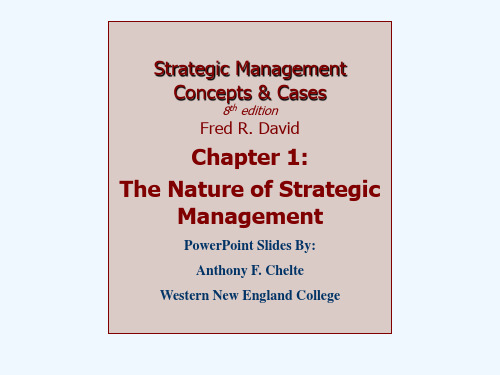
Organizing Themes
• Global considerations impact virtually all strategic decisions.
• E-commerce has become a vital strategic management tool.
• The natural environment has become an important strategic issue.
▪ Widely viewed as panacea for problems
Brief History
• 1980s
➢ Strategic planning cast aside
▪ Planning models did not yield higher returns
• 1990s–2000
➢ Revival of strategic planning
• Strategic planning
➢Refers to:
▪ Strategy formulation
Brief History
• 1950s
➢ Term strategic planning originates
1960s – 1970s ➢ Strategic planning very popular
1. Strategists 2. Vision statements 3. Mission statements 4. External opportunities and threats 5. Internal strengths and weaknesses
Key Strategic Management Terms (Cont’d)
chap5战略管理英语版
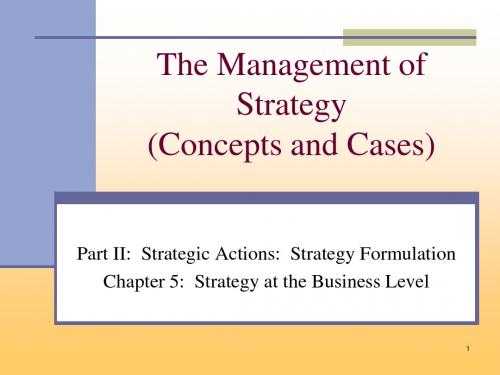
11
Customers: Their Relationship with Business-Level Strategies
(Cont’d)
…Five components of customer relationships 4. What: Determining which customer needs to satisfy
5
Chapter 5: Strategy at the Business Level
Overview: Five content areas
Defining business-level strategy Relationship between customers and strategy Differences in business-level strategies 5-Forces Risks of business-level strategies
但是顾客的选择还和竞争者有关
所以竞争战略的实质是:如何给予顾客较之竞
争者更多的价值
15
提升顾客价值(1)
顾客认知利益:顾客可以识别的各种效用,具体
包括产品的功能、质量、服务、包装、企业形象 等等 顾客认知利益是一种带有主观认知色彩的概念, 是顾客在使用产品或接受服务中获得的实在感受 (受益)。
7
Introduction
(Cont’d)
Customers are the foundation of successful
business strategies
Who will be served by the firm What needs those target customers have that firm will satisfy How those needs will be satisfied by the firm
战略管理概念与案例pdf

战略管理概念与案例pdf战略管理概念与案例。
战略管理是组织中至关重要的一部分,它涉及到组织长期目标的设定和实现。
在竞争激烈的市场环境下,有效的战略管理可以帮助组织保持竞争优势,实现长期发展。
本文将介绍战略管理的基本概念,并结合实际案例进行分析,以便更好地理解和运用战略管理。
首先,我们来了解一下战略管理的基本概念。
战略管理是指组织为实现长期目标而制定和执行的一系列行动计划。
它涉及到对外部环境和内部资源的分析,以及对未来发展方向的选择。
战略管理需要考虑到组织的使命、愿景和价值观,同时也要考虑到市场竞争、技术变革和政策法规等外部因素。
在制定战略时,组织需要考虑到自身的优势和劣势,以及外部机会和威胁,从而找到最适合自身发展的战略方向。
接下来,我们将通过一个实际案例来分析战略管理的实施过程。
以苹果公司为例,该公司在过去几十年里一直保持着创新和市场领先地位。
苹果公司的战略管理体现在多个方面,首先是产品创新,苹果公司不断推出具有创新性的产品,如iPhone、iPad等,这些产品不仅满足了消费者的需求,也带动了整个行业的发展。
其次是品牌营销,苹果公司注重品牌形象和营销策略,通过独特的设计和营销手段,吸引了大量忠实消费者。
再次是全球化战略,苹果公司在全球范围内建立了完善的供应链和销售网络,使得其产品可以迅速覆盖全球市场。
通过以上案例分析,我们可以看到,苹果公司成功的战略管理体现在对市场的洞察和创新能力,以及对品牌和全球市场的有效管理。
这些都是战略管理的重要内容,也是其他组织可以借鉴的经验。
总的来说,战略管理是组织长期发展的重要保障,它需要对内外部环境进行全面分析,找到适合自身发展的战略方向,并通过有效的执行来实现战略目标。
希望本文的介绍和案例分析可以帮助读者更好地理解和运用战略管理的概念,从而为组织的长期发展提供有力支持。
《战略管理概念与案例》

《战略管理概念与案例》
首先,本书提供了对战略管理领域的全面概述。
战略管理是指企业为了长期发展和实现目标而采取的行动和决策。
本书通过对战略管理概念、理论和实践的介绍,帮助读者理解战略管理的重要性和技巧。
同时,本书还介绍了战略管理的起源和演变过程,以及战略管理在不同组织和行业中的应用情况。
其次,本书详细解释了战略管理的概念和要素。
战略管理包括战略规划、战略实施和战略评估等环节。
本书通过对战略管理的基本概念和原理的介绍,帮助读者了解如何制定和实施有效的战略。
此外,本书还介绍了战略管理中的重要要素,如目标设定、资源配置和竞争分析等,帮助读者提高战略管理的能力。
最后,本书通过案例分析的方式,对战略管理进行深入探讨。
本书选取了多个实际案例,涵盖了不同行业和组织的战略管理问题。
通过对这些案例的分析,本书展示了不同战略管理方法和实践的效果,并帮助读者理解如何应对日益复杂和变化的商业环境。
此外,本书还提供了案例解决的思路和方法,帮助读者学习如何运用战略管理知识解决实际问题。
综上所述,《战略管理概念与案例》是一本全面介绍和探讨战略管理的书籍。
通过对战略管理的概念、要素和案例的介绍,本书帮助读者深入理解战略管理的重要性和应用方法,并提高他们的战略管理能力。
这本书不仅适合战略管理领域的学习者和从业者阅读,也适合对战略管理感兴趣的人士阅读。
chap6战略管理英语版
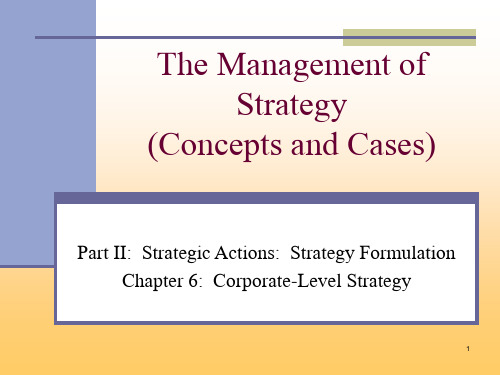
Procter & Gamble’s Diversification Strategy
Procter & Gamble (P&G) (Cont’d) Synergy created with combining toothbrush and toothpaste businesses
10
Levels of Diversification (N=3)
1. Low Levels
Single Business Strategy
Corporate-level strategy in which the firm generates 95% or more of its sales revenue from its core business area
Builds synergy: value added by corporate office adds up to more than the value if different businesses in the portfolio were separate and independent
Dominant Business Diversification Strategy
Corporate-level strategy whereby firm generates 70-95% of total sales revenue within a single business area
11
Levels of Diversification (N=3)
2. Moderate to High Levels
Strategic Management(战略管理-中英文)
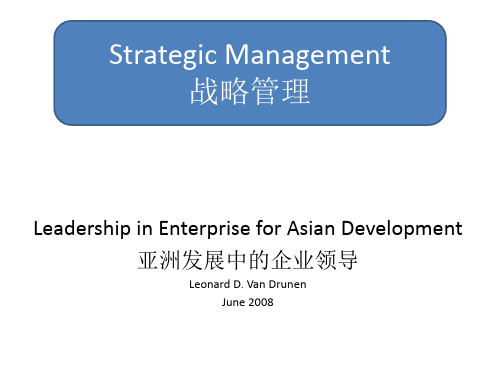
Environments: 环境 •Internal内部 •External 外部
Competing via 竞争方 式…
Rivalry: 竞争 •Business level strategies 经营层次战略 •Multiproduct strategies 产品多元化战略 •Mergers & acquisitions 并购
Competing via 竞争方 式…
Rivalry: 竞争 •Business level strategies 经营层次战略 •Multiproduct strategies 产品多元化战略 •Mergers & acquisitions 并购
Market entry: 市场进入 •Across borders 跨国 •Alliances 联盟 •Entrepreneurship 创业
Market entry: 市场进入 •Across borders 跨国 •联盟 •Entrepreneurship 创业
External Environment Analysis 外部环境分 析
Potential Entrants 潜在竞争 对手 General Environment 总体环境
机动性增加,风险降低,资本需求降低 Allows the firm to focus on its core competencies. 发展核心竞争 力
Potential problems with outsourcing: 外包可能产生的问题 Job losses for the firm’s communities. 企业岗位减少 Hard to reverse outsourcing decisions. 外包决策难以收回
战略管理概念与案例英文版.原书第十五版教学设计 (2)
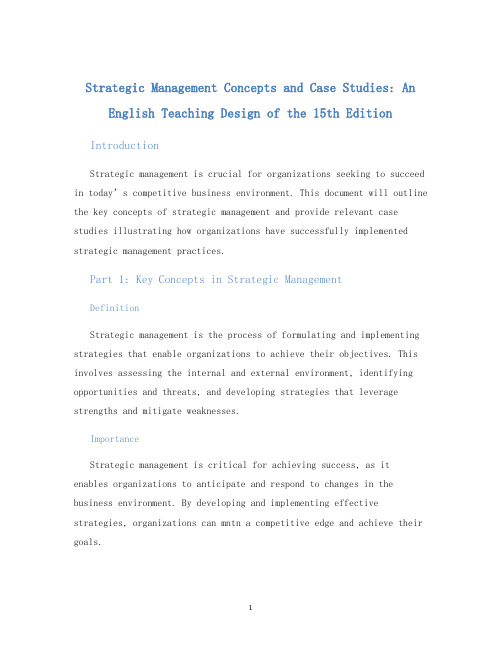
Strategic Management Concepts and Case Studies: An English Teaching Design of the 15th Edition IntroductionStrategic management is crucial for organizations seeking to succeed in today’s competitive business environment. This document will outline the key concepts of strategic management and provide relevant case studies illustrating how organizations have successfully implemented strategic management practices.Part 1: Key Concepts in Strategic ManagementDefinitionStrategic management is the process of formulating and implementing strategies that enable organizations to achieve their objectives. This involves assessing the internal and external environment, identifying opportunities and threats, and developing strategies that leverage strengths and mitigate weaknesses.ImportanceStrategic management is critical for achieving success, as it enables organizations to anticipate and respond to changes in the business environment. By developing and implementing effective strategies, organizations can mntn a competitive edge and achieve their goals.ComponentsThe strategic management process typically involves several key components, including:•Environmental analysis: This involves assessing internal and external factors that may affect an organization’s ab ility toachieve its objectives. Internal factors might includeorganizational culture, resources, and capabilities, whileexternal factors might include competition, technologicaldevelopments, and regulatory changes.•Strategy formulation: Based on the outcomes of environmental analysis, organizations can develop strategies that align withtheir objectives. Strategies may involve market positioning,product development, or organizational restructuring.•Strategy implementation: This involves allocating resources and putting plans into action to implement the chosen strategies.•Evaluation and control: Organizations must regularly evaluate and control their strategies to ensure they remn aligned with objectives and continue to be effective in the changingbusiness environment.Part 2: Case StudiesApple Inc.Apple Inc. is a technology company that has successfully implemented strategic management practices to become one of the most valuable companies in the world. Apple’s environmental analysisidentified the growing popularity of mobile devices and the potential to capture market share. Their strategy formulation involved developing innovative products, such as the iPhone and iPad, that leveraged their strengths in design and functionality. Apple successfully implemented these strategies, garnering a significant share of the mobile device market and achieving its objectives. Inc. Inc. is an e-commerce company that has revolutionized online shopping. Amazon’s environmental analysis identifie d the growing trend of online shopping and the potential to capture market share by offering a wide range of products and convenient delivery options. Its strategy formulation involved investing in technology and logistics infrastructure to streamline the ordering and delivery process. Amazon’s success is evident in its high customer satisfaction ratings and dominant position in the e-commerce market.Coca-Cola CompanyThe Coca-Cola Company is a multinational beverage corporation that has successfully implemented strategic management practices to mntn its position as a leading global brand. Coca-Cola’s environmental analysis identified increased competition and changing customer preferences as threats to its market position. Its strategy formulation involved broadening its product offerings and investing in marketing campgns that emphasized the brand’s heritage and quality. Coca-Cola’s success is evidenced by its global market share and strong brand equity.ConclusionStrategic management is a critical process for achieving success in today’s competitive business environment. By understanding key concepts and learning from successful case studies, organizations can develop and implement effective strategies that enable them to achieve their objectives.。
- 1、下载文档前请自行甄别文档内容的完整性,平台不提供额外的编辑、内容补充、找答案等附加服务。
- 2、"仅部分预览"的文档,不可在线预览部分如存在完整性等问题,可反馈申请退款(可完整预览的文档不适用该条件!)。
- 3、如文档侵犯您的权益,请联系客服反馈,我们会尽快为您处理(人工客服工作时间:9:00-18:30)。
战略管理概念与案例英文版.原书第十五版课程设计Introduction
Strategic management is an important concept in the business world. It involves the process of setting objectives, formulating strategies, and implementing them to achieve the goals of an organization. In this course, we will explore the key concepts and principles of strategic management, as well as examine several case studies of successful and unsuccessful implementation of strategic plans.
Course Objectives
Upon completion of this course, students will be able to:
1.Understand the importance of strategic management in
achieving organizational goals
2.Develop strategies to improve organizational performance
3.Assess the impact of different situational factors on the
implementation of strategic plans
4.Analyze case studies of successful and unsuccessful
strategic management
Course Outline
1.Introduction to Strategic Management
–Definition of strategic management
–Benefits of strategic management
–The strategic management process
2.The External Environment
–Analysis of the external environment
–Porter’s Five Forces Model
–Industry life cycle analysis
3.The Internal Environment
–Analysis of the internal environment
–SWOT analysis
–Resource-based view of the firm
4.Strategy Formulation
–Defining the vision, mission, and values
–Setting strategic objectives
–selecting the right business-level strategy
5.Strategy Implementation
–The role of leadership
–Organizational structure and design
–Strategic control and reward systems
6.Strategic Evaluation and Control
–Assessing performance
–Correcting deviations from the plan
–Making strategic adjustments
7.Case Studies
–Successful strategic management case studies
–Unsuccessful strategic management case studies Textbook
The recommended textbook for this course is。
